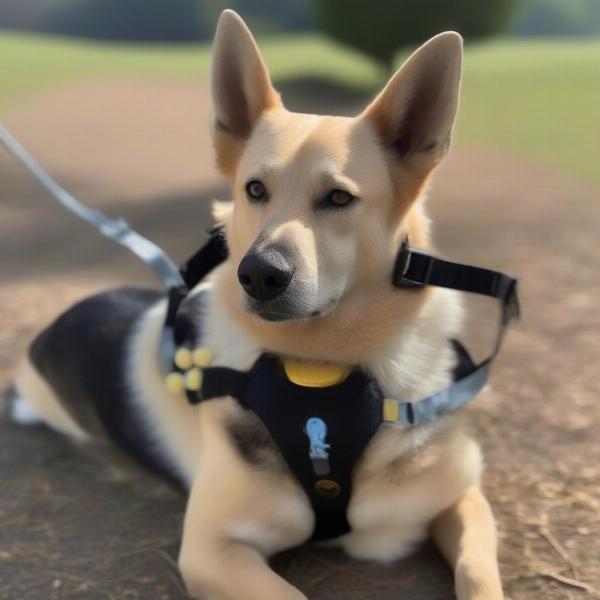Navigating the world with a visually impaired dog requires understanding, patience, and the right tools. “Rigging them right” means providing a safe and comfortable environment that allows them to explore with confidence. This involves more than just a blind dog halo; it encompasses a comprehensive approach to their care, training, and overall well-being. We’ll explore essential aspects of creating a supportive and enriching life for your blind dog.
Understanding Your Blind Dog’s Needs
Blindness in dogs can stem from various causes, including cataracts, glaucoma, progressive retinal atrophy (PRA), and sudden acquired retinal degeneration syndrome (SARDS). Regardless of the cause, understanding the impact on your dog’s daily life is crucial. They rely heavily on their other senses – smell, hearing, and touch – to navigate. This heightened reliance necessitates a consistent and predictable environment.
Creating a Safe Haven at Home
Start by “blind-proofing” your home. Avoid rearranging furniture without introducing your dog to the new layout. Use baby gates to block off stairs or other hazardous areas. Place textured mats in front of doorways and food/water bowls to signal location. Introduce scent markers around the house, using specific scents for different areas.
Harnessing the Power of the Halo: Dog Halo for Blind Dogs
A dog halo, or halo harness for blind dogs, is a crucial tool for visually impaired canines. It acts as a buffer, preventing them from bumping into objects and helping them navigate safely. The halo’s circular frame extends beyond the dog’s head, providing a protective cushion. Choosing the right size and ensuring proper fit are essential for optimal effectiveness.
 Dog wearing a halo harness
Dog wearing a halo harness
Training and Enrichment for Blind Dogs
Training a blind dog involves adapting traditional methods to cater to their unique needs. Focus on verbal cues, hand signals, and tactile rewards. Clicker training can be particularly effective. ring clicker dogs provides more information on using clickers for dog training. Encourage exploration within safe boundaries, using scent trails and interactive toys to stimulate their senses. Mental stimulation is just as important as physical activity.
Socialization and Confidence Building
While a blind dog’s world might seem smaller, socialization is still vital. Introduce them to new environments gradually and provide positive reinforcement during interactions with other dogs and people. Building their confidence is key to helping them thrive. A gun dog book can offer further insights into specialized training techniques.
Dietary Considerations and Veterinary Care
Maintaining a healthy diet and regular veterinary check-ups are essential for any dog, but especially for those with visual impairments. Discuss any specific dietary needs related to your dog’s blindness with your veterinarian. Ensure they receive regular eye exams to monitor their condition and address any potential complications.
Conclusion
Rigging your dog’s blind right involves a holistic approach to their well-being. From creating a safe environment and utilizing helpful tools like the dog halo, to providing tailored training and enrichment activities, your dedication plays a vital role in enabling your blind companion to live a full and happy life. Remember, “rigging them right” is about empowering them to navigate their world with confidence and joy.
FAQ
- How can I help my blind dog adjust to its new reality? Patience, consistency, and positive reinforcement are crucial. Create a predictable environment and introduce changes gradually.
- What are the best toys for blind dogs? Toys that stimulate their other senses, such as those with textures, sounds, or scents, are ideal.
- Can blind dogs still enjoy walks? Absolutely! Use a secure harness and leash, and verbally guide them along familiar routes.
- How can I prevent my blind dog from getting injured? Blind-proof your home by removing obstacles and using barriers for hazardous areas like stairs.
- Are there any specific health concerns for blind dogs? Regular veterinary check-ups are essential to monitor their eye condition and overall health.
- How can I introduce my blind dog to new people or dogs? Do it slowly and calmly, allowing them to sniff and explore at their own pace.
- Where can I find more information about caring for a blind dog? Consult with your veterinarian and connect with online resources and support groups for blind dog owners.
About ILM Dog
ILM Dog is your trusted international resource for all things dog-related. We offer expert advice on dog breeds, health, training, nutrition, grooming, and more. Our goal is to empower dog owners worldwide with the knowledge and resources they need to provide the best possible care for their canine companions. We specialize in providing comprehensive information on various aspects of dog care, from breed selection and health management to training and nutrition. For expert advice and tailored solutions to enhance your dog’s well-being, reach out to us. Email: [email protected], Phone: +44 20-3965-8624. ILM Dog is here to help you every step of the way.